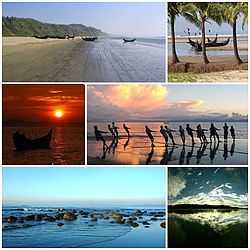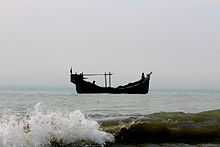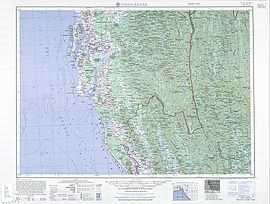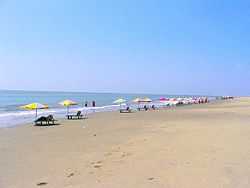Cox's Bazar
| Cox's Bazar কক্সবাজার | |
|---|---|
 | |
 | |
| Coordinates: 21°35′0″N 92°01′0″E / 21.58333°N 92.01667°E | |
| Country |
|
| Administrative District | Cox's Bazar District |
| Area | |
| • City | 6.85 km2 (2.64 sq mi) |
| Elevation | 3 m (10 ft) |
| Population (2007 est.)Total population represents population in city and metro represents entire district.[1] | |
| • City | 51,918 |
| • Density | 7,579.27/km2 (19,630.2/sq mi) |
| • Metro | 120,480 |
| Time zone | BST (UTC+6) |
Cox's Bazar (Bengali: কক্সবাজার Kaksbajar) is a seaside town, a fishing port and district headquarters in Bangladesh. It is known for its wide and long sandy beach, which is considered by many as the world's longest natural sandy sea beach.[2][3] The beach in Cox's Bazar is an unbroken 125 kilometres (78 mi) sandy sea beach with a gentle slope. It is located 150 kilometres (93 mi) south of the industrial port of Chittagong. Cox's Bazar is also known by the name Panowa, whose literal translation means "yellow flower". Its other old name was "Palongkee".


Today, Cox's Bazar is one of the most-visited tourist destinations in Bangladesh. It has yet to become a major international tourist destination, and has no international hotel chains because of the lack of publicity and transportation.
Town
Cox's Bazar municipality was constituted in 1869, eventually becoming a B-grade municipality in 1989. The municipality covers an area of 6.85 square kilometres (2.64 sq mi).[4] Located along the Bay of Bengal in South Eastern Bangladesh, today Cox's Bazar Town is a large port and health resort. But it is famous mostly for its long natural sandy beach. The municipality covers an area of 6.85 square kilometres (2.64 sq mi) with 27 mahallas and 9 wards and has a population of 51,918.[1] Cox's Bazar is connected by road and air with Chittagong.[5]
History
The southern Chittagong area, including Cox's Bazar, was under the rule of Arakan kings from the early ninth century until its conquest by the Mughals in 1666 AD.[6] When the Mughal Prince Shah Shuja was passing through the hilly terrain of the present-day Cox's Bazar on his way to Arakan, he was attracted to its scenic and captivating beauty. He commanded his forces to camp there. His retinue of one thousand palanquins stopped there for some time. A place named Dulahazara, meaning "one thousand palanquins", still exists in the area. After the Mughals, the place came under the control of the Tipras and the Arakanese, followed by the Portuguese and then the British.
The name Cox's Bazar originated from the name of a British East India Company officer, Captain Hiram Cox, who was appointed as the Superintendent of Palonki (today's Cox's Bazar) outpost. He succeeded Warren Hastings, who became the Governor of Bengal after the British East India Company Act in 1773. Cox was mobilised to deal with a century-long conflict between Arakan refugees and local Rakhine people at Palonki. The Captain had rehabilitated many refugees in the area but died in 1799 before he could finish his work. To commemorate that, a market was established and named after him, called Cox's Bazar (market of Cox). Cox's Bazar then was first established in 1854 and became a municipality in 1869.[6]
After the Sepoy Mutiny (Indian Rebellion of 1857) in 1857, the British East India Company was highly criticised and questioned on humanitarian grounds, especially for its opium trade monopoly over the Indian Sub-Continent. However, after its dissolution on 1 January 1874, all of the company's assets including its Armed Forces were acquired by the British Crown. After this historic takeover, Cox's Bazar was declared a district of the Bengal Province under the British Crown.

After the end of British rule in 1947, Cox's Bazar became part of East Pakistan. Captain Advocate Fazlul Karim, the first Chairman (after independence from the British) of Cox's Baazar Municipality, established the Tamarisk Forest along the beach. He wanted to attract tourists as well as to protect the beach from tidal waves (tsunami). He donated much of his father-in-law's and his own lands as sites for constructing a Public Library and a Town Hall. He was inspired to build Cox's Baazar as a tourist spot after seeing beaches of Bombay and Karachi, and was a resort pioneer in developing Cox's Bazar as a destination. He founded a Maternity Hospital, the Stadium and the drainage system by procuring grants from the Ford Foundation and Rockefeller Foundation through correspondence. T. H. Matthews, the principal of the Dacca Engineering College (1949~1954), was a friend who had helped him in these fundraising efforts. Engineer Chandi Charan Das was the government civil engineer who had worked on all these projects. In 1959 the municipality was turned into a town committee.[6]
In 1961 the erstwhile Geological Survey of Pakistan initiated investigation of radioactive minerals like monazite around the Cox's Bazar sea-beach area.[7]

In 1971, Cox's Bazar wharf was used as a naval port by the Pakistan Navy's gunboats. This and the nearby airstrip of the Pakistan Air Force were the scene of intense shelling by the Indian Navy during the Bangladesh Liberation War. During the war, Pakistani soldiers killed many people in the town, including eminent lawyer Jnanendralal Chowdhury. The killing of two freedom fighters named Farhad and Subhash at Badar Mokam area is also recorded in history.[8]
After the independence of Bangladesh, Cox's Bazar started to get administrative attention. In 1972 the town committee of Cox's Bazar was turned into a municipality. In 1975, The Government of Bangladesh established a pilot plant at Kalatali.[7] Later, in 1984 Cox's Bazar subdivision was promoted to a district, and five years later (in 1989) the Cox's Bazar municipality was elevated to B-grade.[6] In 1994 (jobs) the Marine Fisheries and Technology Station (MFTS) was established at Cox's Bazar. MFTS is a research station of Bangladesh Fisheries Research Institute (BFRI) headquartered in Mymensingh. The station covers a land area of four hectares and contains five laboratories.[9] In April 2007 Bangladesh got connected to the submarine cable network as a member of the SEA-ME-WE 4 Consortium, as Cox's Bazar was selected as the landing station of the submarine cable.[10] In September 2012 the municipality was the site of the Cox's Bazar and Ramu riots, where local Muslims attacked the Buddhist community over an alleged Quran desecration posted to Facebook.[11]
Geography and climate

Cox's Bazar town, with an area of 6.85 km², is located at 21°35′0″N 92°01′0″E / 21.58333°N 92.01667°E and bounded by Bakkhali River on the north and East, Bay of Bengal in the West, and Jhilwanj Union in the south.
The climate of Bangladesh is mostly determined by its location in the tropical monsoon region: high temperature, heavy rainfall, generally excessive humidity, and distinct seasonal variations.[12] The climate of Cox's Bazar is mostly similar to the that of rest of the country. It is further influenced by its location in the coastal area. The annual average temperature in Cox's Bazar remains at about a maximum of 34.8 °C and a minimum of 16.1 °C. The average amount of rainfall remains at 4,285 mm.
| Climate data for Cox's Bazar | |||||||||||||
|---|---|---|---|---|---|---|---|---|---|---|---|---|---|
| Month | Jan | Feb | Mar | Apr | May | Jun | Jul | Aug | Sep | Oct | Nov | Dec | Year |
| Record high °C (°F) | 31 (88) |
33 (91) |
35 (95) |
36 (97) |
36 (97) |
35 (95) |
37 (99) |
33 (91) |
33 (91) |
36 (97) |
33 (91) |
30 (86) |
37 (99) |
| Average high °C (°F) | 26.7 (80.1) |
28.5 (83.3) |
30.9 (87.6) |
32.1 (89.8) |
32.3 (90.1) |
30.7 (87.3) |
30.0 (86) |
30.2 (86.4) |
31.6 (88.9) |
31.6 (88.9) |
30.0 (86) |
27.5 (81.5) |
30.2 (86.4) |
| Daily mean °C (°F) | 20.9 (69.6) |
22.8 (73) |
25.8 (78.4) |
28.0 (82.4) |
28.7 (83.7) |
28.0 (82.4) |
27.6 (81.7) |
27.6 (81.7) |
28.3 (82.9) |
28.0 (82.4) |
25.6 (78.1) |
22.0 (71.6) |
26.1 (79) |
| Average low °C (°F) | 15.0 (59) |
17.0 (62.6) |
20.7 (69.3) |
23.9 (75) |
25.1 (77.2) |
25.2 (77.4) |
25.1 (77.2) |
25.0 (77) |
25.0 (77) |
24.3 (75.7) |
21.1 (70) |
16.5 (61.7) |
22.0 (71.6) |
| Record low °C (°F) | 8 (46) |
11 (52) |
13 (55) |
19 (66) |
18 (64) |
21 (70) |
21 (70) |
21 (70) |
21 (70) |
17 (63) |
11 (52) |
11 (52) |
8 (46) |
| Precipitation mm (inches) | 0 (0) |
10 (0.39) |
30 (1.18) |
100 (3.94) |
320 (12.6) |
790 (31.1) |
900 (35.43) |
700 (27.56) |
380 (14.96) |
180 (7.09) |
80 (3.15) |
20 (0.79) |
3,550 (139.76) |
| % humidity | 71 | 69 | 72 | 74 | 78 | 86 | 88 | 89 | 86 | 80 | 74 | 73 | 78 |
| Source: Weatherbase[13] | |||||||||||||
Important educational institutions
Medical Colleges: Cox's Bazar Medical College Colleges: Cox's Bazar Govt. College, Cox's Bazar Woman College, Cox's Bazar City College, Ramu Degree College, Primary Teacher's Training Institute (P.T.I) High Schools: Cox's Bazar Govt. High School, Cox's Bazar Govt. Girls High School,Baitush Sharaf Jabbaria Academy, Cox's Bazar. Korak Bidda-pith, Chokoria, Chokoria Govt. High School, Palong Model High School,Ratna Plong,Ukhiya
Economy and development

As one of the most beautiful and famous tourist spots in Bangladesh, Cox's Bazar has an economy supported primarily by tourism. Millions of tourist and Bangladeshi natives visit this coastal city every year. As a result, a large number of hotels, guest houses and motels have been built in the city and coastal region. Many people are involved in businesses providing hospitality and customer service. Several hotels are available in the city under different budgets, including some of high-end standard. However no renowned international hotel chains operate in the city, but many are under construction. The Carlson Rezidor Hotel Group plans 2 Radissons here in 2015, and another in the port city Chittagong.[14][15][16] A Best Western hotel is expected to be operational in 2014. Mövenpick Hotels & Resorts is on their way to open one in 2013.[17][18]
A number of people are also involved in fishing and collecting seafood and sea products for their livelihood. Various kinds of oyster, snail, and pearl and their ornaments are very popular with tourists in seaside and city stores. A number of people are also involved in the transportation business for tourists. Cox's Bazar is also one of the few major spots for aquaculture in Bangladesh.[19] Along with Khulna, it is considered a major source of revenue from foreign exchanges. Beside a mix of small-scale agriculture, marine and inland fishing and salt production are other industrial sources from this region that play important roles in the national economy.
Tourist attractions near the town

The beach is the main attraction of the town. Larger hotels provide exclusive beachside areas with accessories for the hotel guests. Visitors in other hotels visit the Laboni beach, which is the area of the beach closest to the town. In addition to the beach, there are several places of interest near the town, which can easily be visited from the town center.
- Aggmeda Khyang: a large Buddhist monastery, and a place revered by around 400,000 Buddhist people of Cox's Bazar; and the Chittagong Hill Tracts. The main sanctuary is posted on a series of round timber columns. It has a prayer chamber and an assembly hall along with a repository of large and small bronze Buddha images and a number of old manuscripts.
- Ramu: about 10 kilometres (6.2 mi) from Cox's Bazar,[20] is a village with a sizeable Buddhist population. The village is famous for its handicrafts and homemade cigars. There are monasteries, khyangs, and pagodas containing images of Buddha in bronze, gold, and other metals with precious stones. The temple on the bank of the Baghkhali river houses not only relics and Burmese handicrafts but also a large bronze statue of Buddha measuring thirteen feet in height which rests on a six-foot-high pedestal. Weavers ply their trade in open workshops and craftsmen make handmade cigars in their pagoda-like houses.
- Bangabandhu Sheikh MujibSafari Park: Bangabandhu Sheikh MujibSafari Park is the first Safari Park in Bangladesh. The nature of the forest is tropical evergreen and rich with Garjan, Boilam, Telsur, and Chapalish along with herbs, shrubs, and creepers. Safari Park is a declared protected area where the animals are kept in fairly large areas with natural environments and visitors can see the animals by bus or jeep or on foot. This park was established on the basis of the South Asian model. This safari park is an extension of an animal sanctuary located along the Chittagong-Cox's Bazar road about 50 kilometres (31 mi) from Cox's Bazar town. The sanctuary itself protects a large number of wild elephants that are native to the area. In the safari park, there are domesticated elephants that are available for a ride. Other animal attractions include lions, Bengal tigers, crocodiles, bears, chitals, and many different types of birds and monkeys.
- Inani Beach
Other tourist attractions near Cox's Bazar
- Maheshkhali is a small island (268 square kilometres) off the Cox’s Bazar coast. The island offers panoramic scenic beauty and is covered by a range of low hills, about 300 feet (91 m) high, stretching through the center of the island and along its eastern coastline.[21] Adinath Temple, a temple of Shiva, and a Buddhist pagoda are also located on this island.
- Sonadia Island, a small crescent-shaped island of only 9 square kilometres, is 7 km north-west of Cox's Bazar. The western side of the island is sandy and different kinds of shells are found on the beach. Off the northern part of the island, there are beds of windowpane oysters. During winter, fishermen set up temporary camps on the island and dry their catches of sea fish. Sonadia Island supports the last remaining part of the mangrove forest in southeast Bangladesh.[21][22]
- Teknaf, a place situated by the side of Naf river, is the southernmost part of mainland Bangladesh. This also marks the end point of Cox's Bazar beach. Tourists usually come here to have a river cruise along beautiful Naf river, which flows between Bangladesh and Myanmar.

- St. Martin's Island, a small island in the northeast part of the Bay of Bengal, about 9 km south of the tip of the Cox's Bazar-Teknaf peninsula. It is the only coral island in Bangladesh. It is about 8 km west of the northwest coast of Myanmar at the mouth of the Naf River. The local name of the island is নারিকেল জিঞ্জিরা Narikel Jinjira (also spelled "Narical Gingira", "Narikel Janjina", and "Narikel Jinjera"), meaning "Coconut Island" in Bengali. St. Martin's Island has become a popular tourist spot. Three shipping liners run daily trips to the island. They are Kutubdia, Sea-Truck and Keary-Sindbad. Tourists can book their trip either from Chittagong or from Cox's Bazar. The surrounding coral reef of the island has an extension named Chera Dwip. The island is home to several endangered species of turtles, as well as the corals, some of which are found only on this island.
- Chakaria: One of most large area in Cox's Bazar.
Ramu is one of the best known tourist locations in Cox's Bazar.World biggest Buddhist temple is situated in Ramu.


- Bandarban: Bandarban lies three hours away from Cox's Bazar by bus. The Buddha Dhatu Jadi, the largest Buddhist temple in Bangladesh, located in Balaghata, 4 km from the town, is an excellent place to visit. This Theravada Buddhist temple is made completely in the style of South-East Asia and houses the second largest statue of Buddha in Bangladesh. The waterfall named Shoilo Propat at Milanchari is also an excellent site. In addition, the numerous Buddhist temples, known as kyang in the local tongue, and vihars in the town include the highly notable Rajvihar (royal vihar) at Jadipara and the Ujanipara Vihar. Bawm villages around Chimbuk, and Mru villages a little further off, also lie within a day's journey from the town. Prantik Lake, Jibannagar and Kyachlong Lake are some more places of interest. Also, a boat ride on the Sangu River is an excellent experience.
- Rangamati: One can reach Rangamati from Cox's Bazar via either Chittagong or Bandarban. Rangamati offers several attractions including a local tribal museum, a Buddhist temple, tribal markets, a hanging bridge and even the palace of tribal kings. The major attraction of the district is Kaptai Lake. It is a man-made lake in the Kaptai upazila of Rangamati District. The lake was created as a result of building the Kaptai Dam on the Karnaphuli River, as part of the Karnaphuli Hydro-electric project. The beautiful view of surrounding green hills has turned the lake into a wonderful spot for boating and cruising.
See also
| Wikimedia Commons has media related to Cox's Bazar. |
References
- ↑ 1.0 1.1 Municipal data; Bangladesh Bureau of Statistics
- ↑ "Cox's Bazar, Bangladesh - the World's Longest Beach 120km". Retrieved 2008-01-10.
- ↑ "World's longest beach hidden in Bangladesh". The Sydney Morning Herald. 31 January 2007. Retrieved 2008-01-10.
- ↑
- ↑ Cox’s Bāzār. (2008). In Encyclopædia Britannica. Retrieved 2008-01-14, from Encyclopædia Britannica Online.
- ↑ 6.0 6.1 6.2 6.3 Siddiqi, Mahibbullah (2003). "Cox's Bazar District". In Islam, Sirajul. Banglapedia: national encyclopedia of Bangladesh. Dhaka: Asiatic Society of Bangladesh. ISBN 984-32-0576-6.
- ↑ 7.0 7.1 Chowdhury, Sifatul Quader (2003). "Beach Sand Heavy Mineral". In Islam, Sirajul. Banglapedia: national encyclopedia of Bangladesh. Dhaka: Asiatic Society of Bangladesh. ISBN 984-32-0576-6.
- ↑ Alam, Badiul (2003). "Cox's Bazar Sadar Upazila". In Islam, Sirajul. Banglapedia: national encyclopedia of Bangladesh. Dhaka: Asiatic Society of Bangladesh. ISBN 984-32-0576-6.
- ↑ Kabir, SM Humayun (2003). "Bangladesh Fisheries Research Institute". In Islam, Sirajul. Banglapedia: national encyclopedia of Bangladesh. Dhaka: Asiatic Society of Bangladesh. ISBN 984-32-0576-6.
- ↑ "Much needed Submarine Cable - Bangladesh". Bangladesh Development Gateway. 2 March 2006. Retrieved 2008-01-14.
- ↑ "Muslim protesters torch Buddhist temples, homes in Bangladesh | Reporters Club". Reportersnepal.com. 30 September 2012. Retrieved 2012-10-25.
- ↑ Ahmed, Rafique (2003). "Climate". In Islam, Sirajul. Banglapedia: national encyclopedia of Bangladesh. Dhaka: Asiatic Society of Bangladesh. ISBN 984-32-0576-6.
- ↑ "Weatherbase: Historical Weather For Cox's Bazar". Weatherbase. Retrieved December 2, 2013.
- ↑ Carlson Hotels: Locations
- ↑ Radisson to set foot in Cox's Bazar
- ↑ Wassener, Bettina (23 April 2012). "Hitting the Beach in Bangladesh". The New York Times (Cox's Bazar). Retrieved 30 November 2013.
- ↑ Cox's Bazar to get another luxury hotel
- ↑ Info
- ↑ Peter Reeves. "The Development of Export-Oriented Shrimp Aquaculture in Bangladesh: a preliminary assessment of moves to more intensive production in southeastern Bangladesh". 16th European Conference on Modern South Asian Studies. Prof. Roger Jeffery, Department of Sociology, University of Edinburgh. Archived from the original on 2005-03-22. Retrieved 2008-02-01.
- ↑ Hossain, Mofazzal (2003). "Cox's Bazar". In Islam, Sirajul. Banglapedia: national encyclopedia of Bangladesh. Dhaka: Asiatic Societyof Bangladesh. ISBN 984-32-0576-6.
- ↑ 21.0 21.1 Hossain, Mofazzal. 2003. Cox's Bazar. In the Banglapedia. The Asiatic Society of Bangladesh, Dhaka. P. 145
- ↑ Islam, M Aminul (2003). "Ecologically Critical Area". In Islam, Sirajul. Banglapedia: national encyclopedia of Bangladesh. Dhaka: Asiatic Society of Bangladesh. ISBN 984-32-0576-6.
Coordinates: 21°35′N 92°01′E / 21.583°N 92.017°E